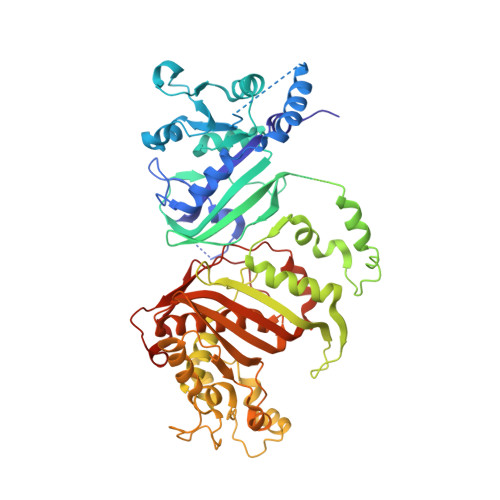Malarial dihydrofolate reductase as a paradigm for drug development against a resistance-compromised target
Yuthavong, Y., Tarnchompoo, B., Vilaivan, T., Chitnumsub, P., Kamchonwongpaisan, S., Charman, S.A., McLennan, D.N., White, K.L., Vivas, L., Bongard, E., Thongphanchang, C., Taweechai, S., Vanichtanankul, J., Rattanajak, R., Arwon, U., Fantauzzi, P., Yuvaniyama, J., Charman, W.N., Matthews, D.(2012) Proc Natl Acad Sci U S A 109: 16823-16828
- PubMed: 23035243
- DOI: https://doi.org/10.1073/pnas.1204556109
- Primary Citation of Related Structures:
4DDR, 4DP3, 4DPD, 4DPH - PubMed Abstract:
Malarial dihydrofolate reductase (DHFR) is the target of antifolate antimalarial drugs such as pyrimethamine and cycloguanil, the clinical efficacy of which have been compromised by resistance arising through mutations at various sites on the enzyme. Here, we describe the use of cocrystal structures with inhibitors and substrates, along with efficacy and pharmacokinetic profiling for the design, characterization, and preclinical development of a selective, highly efficacious, and orally available antimalarial drug candidate that potently inhibits both wild-type and clinically relevant mutated forms of Plasmodium falciparum (Pf) DHFR. Important structural characteristics of P218 include pyrimidine side-chain flexibility and a carboxylate group that makes charge-mediated hydrogen bonds with conserved Arg122 (PfDHFR-TS amino acid numbering). An analogous interaction of P218 with human DHFR is disfavored because of three species-dependent amino acid substitutions in the vicinity of the conserved Arg. Thus, P218 binds to the active site of PfDHFR in a substantially different fashion from the human enzyme, which is the basis for its high selectivity. Unlike pyrimethamine, P218 binds both wild-type and mutant PfDHFR in a slow-on/slow-off tight-binding mode, which prolongs the target residence time. P218, when bound to PfDHFR-TS, resides almost entirely within the envelope mapped out by the dihydrofolate substrate, which may make it less susceptible to resistance mutations. The high in vivo efficacy in a SCID mouse model of P. falciparum malaria, good oral bioavailability, favorable enzyme selectivity, and good safety characteristics of P218 make it a potential candidate for further development.
Organizational Affiliation:
BIOTEC, National Science and Technology Development Agency, Thailand Science Park, Pathumthani 12120, Thailand. yongyuth@biotec.or.th

















